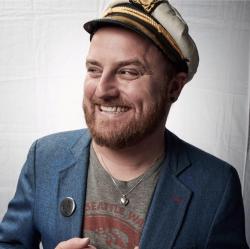Watching Ta-Nehisi Coates Shadowbox With White Nonsense In San Francisco
Guest Post by Sayre Piotrkowski
For most of the past month I have been reading We Were Eight Years In Power by my favorite author, Ta-Nehisi Coates. The book is something like a greatest hits collection culled from Coates’ work in the pages of the Atlantic magazine. Nine essays, eight of them previously published, surrounded by autobiographical and self critiquing “notes” on each year. If you are old enough to have listened to a Roots album while reading the liner notes Questlove would include with each CD, it is kind of like that.
To my ear Coates has always sounded like an MC. Most of the moments in the Coates catalog that stick with me are tied, either explicitly or slyly, to hip-hop. For example, in my favorite section of the new book entitled “Notes On The Fourth Year” Coates writes…
“I had absorbed an essential message, an aesthetic from the hip-hop of that era. Art was not an after school special. Art was not motivational speaking. Art was not sentimental. It had no responsibility to be hopeful or optimistic or make anyone feel better about the world. It must reflect the world in all its brutality and beauty, not in hopes of changing it but in the mean and selfish desire to not be enrolled in its lie, to not be co-opted by the television dreams, to not ignore the great crimes all around us.”
Later he cites a specific example of such art in action…
“I remember the first time I heard “Fight The Power” specifically the line where Chuck D assails Elvis and John Wayne as racist. It’s true that Elvis was not one, while John Wayne was, but this misses the point. The line evinced a total disrespect and ill regard for America’s hallowed heroes and insisted that the pop culture of plunderers be as the theft it was. Chuck treated the claims of the masters with the contempt they’d earned.”
Coates’s writing operates in much the same way. He does not simply debate the falsehoods at the core of the American story, he obliterates and vandalizes them. At his best Coates functions like a graffiti artist, defacing the lying billboards of American history and turning them into canvas for honest work.
“And they are torturing Muslims, and their drones are bombing wedding parties (by accident!), and the Dreamers are quoting Martin Luther King and exulting nonviolence for the weak and the biggest guns for the strong.”
I grew up among Coates’s “Dreamers.” In the 1980s Sonoma County, CA was transitioning from a rural community fueled by farming to a suburban white liberal enclave populated by upwardly mobiles who commuted into jobs in the San Francisco Bay Area. My father, a first generation immigrant, who arrived here at five years old speaking no English, was by the time I met him a respected and wealthy member of our white American community. He spent his days on the phone with other important white men, property owners, banks and title companies.
My father’s home sat on the same piece of country land where my grandmother tended to hens and my grandfather hauled scrap iron. However, I came up quite differently than my father and my uncle Nate. I had my own room big enough for two beds and a large desk. Both my sisters had the same. My father had the free time to coach Little League and my Bar Mitzvah was a more lavish affair than some weddings I’ve attended.
My mother’s house was different. While she my and father were married for over a decade, that all came before me. I was the product of a weekend getaway taken in hopes of saving a doomed marriage. As a result I have always had something of a two-sided life. My mother’s neighborhood was by no means poor, in fact it was only a couple of freeway exits from Dad’s house. Still, as early as I can recall I considered my mother and father to live largely in two different worlds.
At Mom’s place the kids came home to empty houses after school. Left to our own devices we took to the older kid’s influence when it came to how we talked, what we wanted to wear and, most importantly for me, what we listened to. I was introduced to 2 Live Crew, NWA, Too Short, and Public Enemy cassettes at eight and nine years old.
In “Notes From The Fourth Year” Coates details being ten years old in 1985 and sitting down in front of a boombox with a pad and pencil attempting to capture every word of LL Cool J’s “I Can’t Live Without My Radio.”
“I had to have it. I had to trap it on paper, consume it, make it mine: “My radio, believe me I like it loud/ I’m the man with the box that can rock the crowd.”
Last Wednesday night I heard Coates read this section aloud at Nourse Theater in San Francisco. As I listened I realized I had done almost the exact same thing at nine years old, only for me it was the first verse DOC’s “It’s Funky Enough” that I had to grab hold of.
“Enunciate well, so that you can tell/ I am not illiterate no not even a little bit/ Nothing like an idiot, get it/ You want the record, cool, I’m with it”
Back then, I didn’t understand the intricacies of DOC’s patterns, or why Dr. Dre’s production sounded the way it did. All I knew was that this was the strongest, realest, most exhilarating thing I’d ever heard, and that I wanted more of it.
I started chasing down the meaning of hip-hop lyrics, often leading to some very colorful conversations with my mother. I recall asking my mother for a copy of Huey P. Newton’s autobiography Revolutionary Suicide at eleven years old. Around that same time I made my mom buy me a red black and green Malcolm X hat. In wanting to wear the hat, I also came to want to know more about Malcolm and made my first attempt at his autobiography in the summer before Junior High.
I was an “Angry Black White Boy” years before Adam Mansbach gave us a name. This persona was an odd-fit for my California Distinguished High School where I took honors classes and tried to convince girls I was cool because I knew the names and aliases of all nine (ten if you counted Cappadonna) members of the Wu-Tang Clan.
In the view of most of my high school classmates I was what they might refer to as a “wigger,” a white kid who seemed to want to be Black. In that regard I suppose they were not entirely wrong. Really, I wanted to be a rapper and all of them were Black, so that was who I mimicked. I mimicked the rappers I admired in the clothes I wore, the language I used, and in my general distrust of all that was assumed to be correct by those with authority around me.
For Coates’s hip-hop was an acknowledgement of his own experience. One that existed outside of the polite societal edicts of what constituted “acceptable” representation. For me, tucked into my suburban dream, I just knew everyone was wrong. The things I heard in the music I loved and the books that music led me to read, synced up with the fact that life at Mom’s was different. And all of this together told me that somebody had to be lying. I was still far too privileged and socialized such that I could not match Chuck D’s “contempt” for “the claims of the masters,” but I had learned to take pride in my skepticism and greet all of the given ways of my father’s world with rolling eyes.
Perhaps this is why of all Ta-Nehisi Coates’s brilliant work the piece that has resonated most for me was a single tweet:
It was really important. But the burden of whiteness is this: You can live in the world of myth and be taken seriously.
— Ta-Nehisi Coates (@tanehisicoates) December 24, 2014
“But the burden of whiteness is this: You can live in the world of myth and be taken seriously,”
This tweet came as part of a larger series of tweets responding to racist, anti-Muslim statements from the owner of The New Republic. In this series Coates likens the assertion that “Muslim life is cheap” to nonsensical beliefs Coates himself held as a teen with regard to the inherent evil of whites, and inherent nobility of Africans. Coates espouses much gratitude to the college professors who made it their business to disabuse him of these notions because “they knew if I ever went out and said that in front of any group of well-read people, I would get my head cut off.”
I was reminded of this last Wednesday night at the Nourse Theater. As is typical Coates’s remarks were followed by a brief question and answer period. Having attended many events of this sort I was weary before the Q&A even began and sadly my fears were born out.
The Q&A was dominated, as they most often are, by white audience members, mostly men, who raised their hands to make statements disguised as inquiry. Most of the “questions” came with lengthy self-aggrandizing preambles. The most offensive of these came from a man who wished to register his disappointment that in Coates’s discussion of gentrification, a discussion which spanned from slavery up through redlining, the drug war, and on to present-day socioeconomic phenomena, that Coates had not mentioned fraud. “In this city,” the white man told Coates, “greed is colorblind.”
Remarkably, just as he does in the video below (not from the event I attended) Coates practiced a form of intellectual and rhetorical tai-chi, throughout the Q&A period. A “special technique” which combined wisdom, humor and history to repeatedly redirect the inertia of white nonsense back against itself and sever heads.
Watching this video I can’t help but think of Rakim, of KRS-One, of LL Cool J. The flourish that Coates begins at 3:30 seconds with “you are taught that everything belongs to you” feels to me exactly like the moment when LL Cool J took the best line from Canibus’s “Second Round KO” and judo-flipped its full weight back upon the unsuspecting youngster…
“Ask Canibus, he ain’t understanding this/Cause 99% of his fans, don’t exist”
For those of us raised in the dream the work is having the white world’s nonsense shaken out of us. As white people endeavoring to get beyond the myths, we are going to be slammed against the mat. We are going to feel the weight of our false presumptions fall against our chests. This will come with feelings of shame and embarrassment. But that cost is negligible when compared with indulging the lies and half-truths built up to leave you and I smiling and unbruised in a world where so many suffer.
Thank you Ta-Nehisi Coates, for the bruises.










